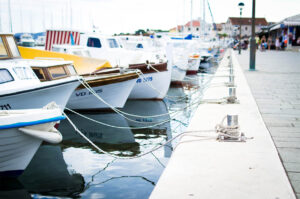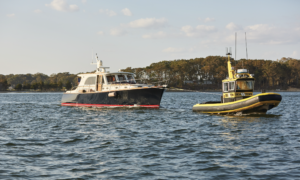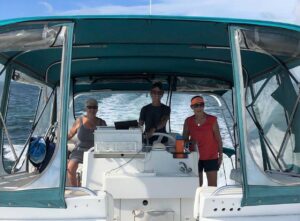Anchored off Rodriguez Key in Florida, we were waiting for sunrise to make the 10-hour run to Cat Cay, Bahamas, when the radio crackled to life. The voice coming over the VHF politely asked if any seven-to eight-knot boats were interested in a buddy boat crossing of the Gulf Stream that day.
This sounded like an innocent request, as many boaters making an ocean voyage, especially for the first time, seek the company of another boat. After all, there’s safety in numbers, isn’t there? On the surface it appears so, but if we explore scenarios of how boats traveling together assist each other, that feeling of safety may turn out to be an illusion.
For as long as ships have been at sea, boaters have felt a moral or legal obligation to help a ship in need. The U.S. Code of Federal Regulations, Title 46, Section 2304 states, “A master or individual in charge of a vessel shall render assistance to any individual found at sea in danger
of being lost, so far as the master or individual in charge can do so without serious danger to the master’s or individual’s vessel or individuals on board.” The penalty for not complying with this law: “A master or individual violating this section shall be fined not more than $1,000, imprisoned for not more than two years, or both.”
The strong history of boaters aiding others comes not out of fear of the law but from human decency and the knowledge that the tables could be turned one day. However, accepting responsibility to assist another vessel at sea should not be taken casually — especially when you agree to travel with recent acquaintances but know nothing of their experience or their boat’s condition.
My wife and I meet the nicest people boating and frequently travel with boater friends. However, we do it purely for the social reasons, not for a perceived sense of safety.
Boaters can assist or support each other in three ways when traveling together:
Sharing Information
Nothing beats local knowledge when traveling to new places aboard your boat. If friends were there before, they can share their routes and knowledge of the area’s unique features. Following other boaters who are familiar with an inlet or channel can also provide a safe way along a new course.
Comforting Company
This is an important and understandable aspect of buddy boating. When making a long passage across open water or an overnight run on a moonless night, you might find comfort in seeing your companion boat’s radar echo or AIS symbol on what might otherwise be your radar’s dark blank screen. It’s reassuring to call your buddy boat on the VHF during a long offshore run.
Lending Physical Support
Being physically able to assist fellow boaters provides many with the feeling of security they seek in buddy boating. But the idea that you can help each other if one boat experiences a problem is potentially the most problematic aspect of buddy boating.
The most obvious assistance that comes to boaters’ minds is towing the companion boat after a mechanical breakdown. However, most recreational boats are not set up to tow another boat, and specialized knowledge is required to do it correctly and safely. First, consider the risk of two boats getting close enough to each other in open water to pass a line from boat to boat. Second, select the proper line to tow safely. Experts recommend a line 8 to 10 times the length of the boat being towed, which could be 400 to 500 feet long for a medium-size pleasure boat. Most boaters don’t carry lines that long aboard their boats.
Having the correct type of line with the proper strength is also unlikely. Three-strand nylon, the most common dock line, is also the most dangerous tow line.  It allows too much stretch and can break with explosive results. Last of all, unsuitable attachment points aboard each boat can be a problem. Cleats may not be reinforced sufficiently or located properly to act as tow points. Towing is best left to professionals with the knowledge and hardware to do it correctly.
It allows too much stretch and can break with explosive results. Last of all, unsuitable attachment points aboard each boat can be a problem. Cleats may not be reinforced sufficiently or located properly to act as tow points. Towing is best left to professionals with the knowledge and hardware to do it correctly.
What if your buddy boat doesn’t need to be towed? What if they only need help repairing an item on the boat or a spare part? What if they need first aid or medical care? All of these require transferring a person from boat to boat, which comes with great risk in any large open body of water.
The most extreme scenario would be losing a boat and retrieving people from the water or a life raft. Think carefully about how you’d accomplish this before assuming it’s easy. Coast Guard rescue vessels are designed with a special area to bring someone into the boat, and its personnel train and rehearse techniques to perform this safely. Of course, we’d all attempt to rescue a stranded boater, but don’t assume it’s simple and without risk to everyone.
Organized ocean crossing rallies that specialize in long-distance travel in the safety of fellow boaters often identify and outfit specific boats to perform towing and rescue functions. Rally organizers typically require vessel inspections to reduce the chances of a breakdown.
We certainly don’t mean to discourage boaters from traveling with companions. Instead we encourage boaters to have realistic expectations of what they can reasonably and safely offer each other. When traveling with friends, discuss ahead of time what each would do if one boat has trouble along the way. Go fully prepared with spare parts and the knowledge to handle emergencies on your own. Utilize a pre-departure checklist for every buddy boat traveling together to hedge against the chances of a problem occurring. Then enjoy the best part of traveling with fellow boaters — the bonds of friendship built through shared experiences and an evening toast to each other on a successful arrival at your destination.





